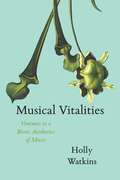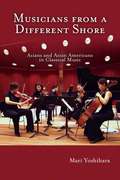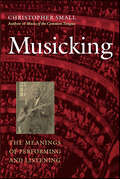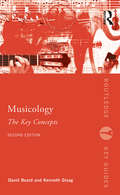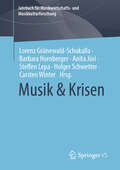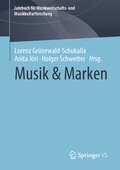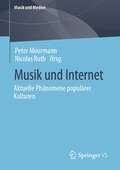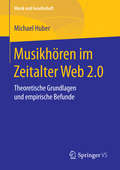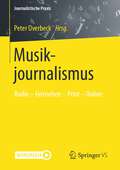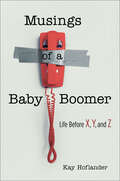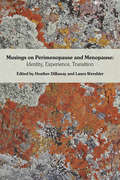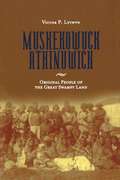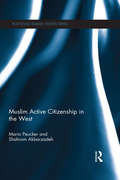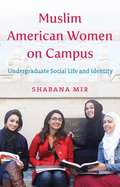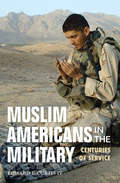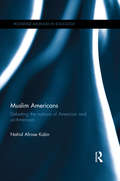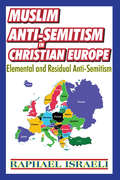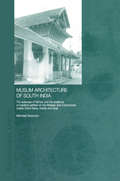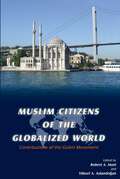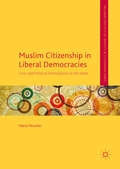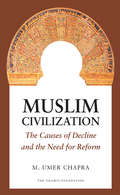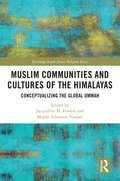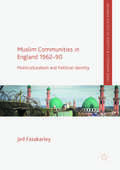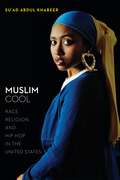- Table View
- List View
Musical Vitalities: Ventures in a Biotic Aesthetics of Music (New Material Histories of Music)
by Holly WatkinsDoes it make sense to refer to bird song—a complex vocalization, full of repetitive and transformative patterns that are carefully calculated to woo a mate—as art? What about a pack of wolves howling in unison or the cacophony made by an entire rain forest? Redefining music as “the art of possibly animate things,” Musical Vitalities charts a new path for music studies that blends musicological methods with perspectives drawn from the life sciences. In opposition to humanist approaches that insist on a separation between culture and nature—approaches that appear increasingly untenable in an era defined by human-generated climate change—Musical Vitalities treats music as one example of the cultural practices and biotic arts of the animal kingdom rather than as a phenomenon categorically distinct from nonhuman forms of sonic expression. The book challenges the human exceptionalism that has allowed musicologists to overlook music’s structural resemblances to the songs of nonhuman species, the intricacies of music’s physiological impact on listeners, and the many analogues between music’s formal processes and those of the dynamic natural world. Through close readings of Austro-German music and aesthetic writings that suggest wide-ranging analogies between music and nature, Musical Vitalities seeks to both rekindle the critical potential of nineteenth-century music and rejoin the humans at the center of the humanities with the nonhumans whose evolutionary endowments and planetary fates they share.
Musicians from a Different Shore: Asians and Asian Americans in Classical Music
by Mari YoshiharaIn the first book to account for the growing prominence of Asians in the world of Western classical music, Mari Yoshihara grapples with the significance of this trend. This is a book about the about the origins of a social and cultural phenomenon, but it is also about the lives and work of individual musicians devoted to their art.
Musicking: The Meanings of Performing and Listening (Music Culture)
by Christopher SmallExtending the inquiry of his early groundbreaking books, Christopher Small strikes at the heart of traditional studies of Western music by asserting that music is not a thing, but rather an activity. In this new book, Small outlines a theory of what he terms "musicking," a verb that encompasses all musical activity from composing to performing to listening to a Walkman to singing in the shower. Using Gregory Bateson's philosophy of mind and a Geertzian thick description of a typical concert in a typical symphony hall, Small demonstrates how musicking forms a ritual through which all the participants explore and celebrate the relationships that constitute their social identity. This engaging and deftly written trip through the concert hall will have readers rethinking every aspect of their musical worlds.
Musicology: The Key Concepts (Routledge Key Guides)
by David Beard Kenneth GloagNow in an updated 2nd edition, Musicology: The Key Concepts is a handy A-Z reference guide to the terms and concepts associated with contemporary musicology. Drawing on critical theory with a focus on new musicology, this updated edition contains over 35 new entries including: Autobiography Music and Conflict Deconstruction Postcolonialism Disability Music after 9/11 Masculinity Gay Musicology Aesthetics Ethnicity Interpretation Subjectivity With all entries updated, and suggestions for further reading throughout, this text is an essential resource for all students of music, musicology, and wider performance related humanities disciplines.
Musik & Krisen (Jahrbuch für Musikwirtschafts- und Musikkulturforschung)
by Holger Schwetter Lorenz Grünewald-Schukalla Carsten Winter Anita Jóri Steffen Lepa Barbara HornbergerDie vergangenen Jahre waren für Musikkultur und Musikwirtschaft durch tiefe Krisen gekennzeichnet. Die Maßnahmen gegen die Covid-19 Pandemie griffen nicht nur tief in den Alltag der Menschen ein, sondern mit der zeitweisen Absage jeglicher Clubveranstaltungen, Festivals und dem öffentlichen Konzertwesen kam ausgerechnet jener Bereich komplett zum Erliegen, der in den Jahren davor ein starkes Wachstum verzeichnet hatte und im Tonträgermarkt wegbrechende Einnahmen kompensierte. Für viele AkteurInnen der Branche ist damit zumindest kurzfristig die gesamte Existenzgrundlage zusammengebrochen. Der vorliegende Band richtet sich an ForscherInnen wie auch PraktikerInnen aus Musikwirtschaft und Musikkultur und betrachtet das Thema aus diesem Anlass einmal ganz grundlegend. Denn Musik kann auch und gerade in Krisenzeiten vielfältige Rollen spielen: Sie kann Stellung beziehen, Trends thematisieren oder geteilten Emotionen eine Form geben. Zugleich steckt in jeder Krise ein transformatorisches Potential: Krisen beschleunigen Entwicklungen und können hierzu leider auch missbraucht werden. Der Band liefert Beiträge zu Fragen wie: Wie haben MusikkünstlerInnen auf die Corona-Situation reagiert? Wie verändern sich gegenwärtig der Musikmarkt und Musikkulturen? Welche Rolle spielt (und spielte) Musik in Transformationsprozessen, die durch Krisen ausgelöst werden?
Musik & Marken (Jahrbuch für Musikwirtschafts- und Musikkulturforschung)
by Holger Schwetter Lorenz Grünewald-Schukalla Anita JóriSpätestens seit den frühen Formationen einer auf Notendrucken basierenden Musikindustrie unterhalten musikferne Unternehmen Beziehungen zu Musik und ihren Akteur*innen. Damals wurden vornehmlich Kosmetik und Tabakprodukte in Notenbüchern beworben. Heute jedoch haben sich die Formen, bei denen Musik in den kommerziellen Aktivitäten musikferner Akteur*innen eine Rolle spielt, ausdifferenziert. Gleichzeitig hat der Markt für Aktivitäten wie Sponsoring oder Werbung an Volumen zugenommen. Hierbei spielen Marken eine besondere Rolle. Um Marken aufzubauen publizieren Unternehmen Musikmagazine, vertreiben Tonträger, organisieren und streamen Konzerte oder nehmen gar Künstler*innen mit eigenen Labels unter Vertrag. Gleichzeitig werden auch Künstler*innen und Bands durch die Musikindustrie immer stärker als Marken aufgebaut. Das Jahrbuch der GMM „Musik & Marken“ sondiert die Forschung zu Musik und Marken, versammelt empirische Befunde und zeigt neue Forschungsperspektiven in der Untersuchung von „Musik & Marken“ auf.
Musik und Internet: Aktuelle Phänomene populärer Kulturen (Musik und Medien)
by Peter Moormann Nicolas RuthStreaming-Plattformen und soziale Medien sind geprägt von mannigfaltigen musikalischen Formen und Inhalten. Mit ihren jeweiligen Oberflächen bzw. Gestaltungs- und Kommunikationsrahmen ermöglichen und prägen sie aktuelle Musikkulturen. Neben lang etablierten Formen, wie dem Popsong, die mehr und mehr von den Plattformlogiken und verkürzten Aufmerksamkeitsspannen strukturell beeinflusst werden, finden sich auch zahlreiche neue Phänomene, die sich aus alltäglichen Netzkulturen herausgebildet haben. Durch die unterschiedlichen Perspektiven und Phänomenaspekte des Bandes wird deutlich, wie relevant das Internet für aktuelle Musikkulturen ist und in welch komplexen Konstellationen dabei Musik gestaltet, distribuiert und rezipiert wird.
Musikhören im Zeitalter Web 2.0
by Michael HuberIn Anschluss an aktuelle Erkenntnisse soziologischer und sozialpsychologischer Musikrezeptionsforschung erläutert der Band, welche gesellschaftlichen Funktionen das Musikhören heute erfüllt und welche Rolle hier die neuen Rahmenbedingungen im Web 2.0 spielen. Auf Basis repräsentativer empirischer Erhebungen werden musikalische Einstellungen und Verhaltensweisen illustriert sowie klar abgrenzbare Musikhörtypen charakterisiert, die in je besonderer Weise mit den aktuellen Möglichkeiten und Herausforderungen der digitalen Mediamorphose umgehen. Besondere Berücksichtigung findet dabei die Frage nach der Bedeutung primärer Sozialisation als Gegengewicht zur musikalischen Selbstsozialisation im Internet. Vor allem Alter, Schulbildung und Wohnortsgröße der Menschen zeigen sich als entscheidende Einflussgrößen der individuellen musikalischen Praxis in Österreich.
Musikjournalismus: Radio – Fernsehen – Print – Online (Journalistische Praxis)
by Peter OverbeckDieses Buch vermittelt die Grundlagen des Musikjournalismus. Erfahrene Praktiker informieren über die verschiedenen journalistischen Tätigkeiten – von der Programmgestaltung über die Musikkritik bis zur Moderation von Musiksendungen und Interviews mit Musikern in den Musiksparten von Klassik bis Pop. Die Besonderheiten in Radio, Fernsehen, Print und Online werden anhand zahlreicher Beispiele analysiert, die Funktion und der Einsatz von Musik sowie sprachliche, dramaturgische und gestalterische Mittel erörtert. Es gibt Tipps zum Berufsbild und zur Ausbildung und zu den vielfältigen Tätigkeiten.
Musings of a Baby Boomer: Life Before X, Y, and Z
by Kay HoflanderAn honest, humorous, and refreshing look back on the experiences of a unique generation and the challenges of growing older in the digital age.Musings of a Baby Boomer: Life Before X, Y, and Z is a collection of selected shorts from Hoflander&’s weekly newspaper column &“Full Circle,&” featuring sometimes funny and sometimes philosophical stories with a continuous theme: the reluctant, but generally happy, aging of the Baby Boomer generation. In this collection, Hoflander tells stories about everything from yard flamingos and college move-in day to battling internet bots. She reflects on the simpler times of her childhood and addresses present-day changes to which, as a baby boomer, she adapts: memory loss, evolving technology, and politics. Through it all, she uses humor and wit to remind readers not to take life too seriously—and to focus on the things that really matter.&“This book entails family, friends, and wisdom from the perspective of the baby boomer generation! A great read for all! Delightful.&” —Teresa Parson, First Lady of Missouri&“America needs healing, and instead of destroying our history, perhaps musings from those who have been part of history can provide a way forward. That is what Kay Hoflander's book offers.&” —Lieutenant Colonel Allen B. West (US Army, Retired), Member, 112th U.S. Congress, Former Chairman, Republican Party of Texas&“Hoflander has the magical skills to hit upon daily life with humor and understanding . . . For younger readers, this book just may help you better understand your parents or grandparents. It is a book for all generations to enjoy.&” —Suzanne Skelly, University of Missouri Graduate Educator, Realtor, Genealogist and life-long Bibliophile
Musings on Perimenopause and Menopause: Identity, Experience, Transition.
A woman muses about buying lovely new panties; another sets out on the trip of a lifetime; a blogger offers information, support, and community to perimenopausal women; researchers uncover myths and misconceptions about migrant and refugee women's experiences of menopause; a gerontology scholar extrapolates for menopause the meanings of cultural representations of childbirth; a sociologist and intersex advocate challenges her medically constructed menopause; young women's stories inform an inquiry into the health and social repercussions of primary ovarian insufficiency—all in a collection of research papers and personal narratives that moves far beyond the idea of menopause as a mere biological marker. While biomedical and feminist researchers agree that menopause is a time of transition and border crossing, they offer diverse viewpoints about whether perimenopause and menopause signal deficiency and burden, or growth and freedom, or both. So too, contributors to this collection—influenced by factors of age, cultural background, societal context, and physical and psychological experience—vary significantly in their perspectives of this process. Research, analysis, narrative, poetry, and art intermingle to create a multi-textured montage that challenges stereotypes, probes relationships, and defies categorization. Musings on Perimenopause and Menopause: Identity, Experience, Transition provides insight into how women think about and experience the transition to menopause in contemporary times.
Muskekowuck Athinuwick: Original People of the Great Swampy Land (Manitoba Studies in Native History #12)
by Victor P. LytwynThe original people of the Hudson Bay lowlands, often known as the Lowland Cree and known to themselves as Muskekowuck Athinuwick, were among the first Aboriginal peoples in northwestern North America to come into contact with Europeans. This book challenges long-held misconceptions about the Lowland Cree, and illustrates how historians have often misunderstood the role and resourcefulness of Aboriginal peoples during the fur-trade era. Although their own oral histories tell that the Lowland Cree have lived in the region for thousands of years, many historians have portrayed the Lowland Cree as relative newcomers who were dependent on the Hudson's Bay Company fur-traders by the 1700s. Historical geographer Victor Lytwyn shows instead that the Lowland Cree had a well-established traditional society that, far from being dependent on Europeans, was instrumental in the survival of traders throughout the network of HBC forts during the 18th and 19th centuries.
Muslim Active Citizenship in the West (Routledge Islamic Studies Series)
by Mario Peucker Shahram AkbarzadehMuslim Active Citizenship in the West investigates the emergence and nature of Muslims’ struggle for recognition as full members of society in Australia, Great Britain and Germany. What actions have been taken by Muslims to achieve equal civic standing? How do socio-political and socio-economic factors impact on these processes? And how do Muslims negotiate their place in a society that is often regarded as sceptical – if not hostile – towards Muslims’ desire to belong? This book sheds new light on Muslims’ path towards citizenship in Australia, Great Britain and Germany. Existing research and statistics on Muslims’ socio-economic status, community formation, claim-making and political responses, and the public portrayal of Islam are systematically examined. These insights are tested ‘through the eyes of Muslims’, based on in-depth interviews with Muslim community leaders and other experts in all three countries. The findings offer unique perspectives on Muslim resilience to be recognised as equal citizens of Islamic faith in very different socio-political national settings. Pursuing an interdisciplinary and comparative approach, this book examines the country-specific interplay of historical, institutional, political, and identity dimensions of Muslims’ active citizenship and will be invaluable for students and researchers with an interest in Sociology, Religious Studies and Political Science.
Muslim American Women on Campus
by Shabana MirShabana Mir's powerful ethnographic study of women on Washington, D.C., college campuses reveals that being a young female Muslim in post-9/11 America means experiencing double scrutiny--scrutiny from the Muslim community as well as from the dominant non-Muslim community. Muslim American Women on Campus illuminates the processes by which a group of ethnically diverse American college women, all identifying as Muslim and all raised in the United States, construct their identities during one of the most formative times in their lives. Mir, an anthropologist of education, focuses on key leisure practices--drinking, dating, and fashion--to probe how Muslim American students adapt to campus life and build social networks that are seamlessly American, Muslim, and youthful. In this lively and highly accessible book, we hear the women's own often poignant voices as they articulate how they find spaces within campus culture as well as their Muslim student communities to grow and assert themselves as individuals, women, and Americans. Mir concludes, however, that institutions of higher learning continue to have much to learn about fostering religious diversity on campus.
Muslim Americans in the Military: Centuries of Service (Encounters: Explorations in Folklore and Ethnomusicology)
by Edward E. Curtis IVStories of Muslims who have served, dating back to the Revolutionary War. Since the Revolutionary War, Muslim Americans have served in the United States military, risking their lives to defend a country that increasingly looks at them with suspicion and fear. In Muslim Americans in the Military: Centuries of Service, Edward E. Curtis illuminates the long history of Muslim service members who have defended their country and struggled to practice their faith. With profiles of soldiers, marines, airmen, and sailors since the dawn of our country, Curtis showcases the real stories of Muslim Americans, from Omer Otmen, who fought fiercely against German forces during World War I, to Captain Humayun Khan, who gave his life in Iraq in 2004. These true stories contradict the narratives of hate and fear that have dominated recent headlines, revealing the contributions and sacrifices that these soldiers have made to the United States.
Muslim Americans: Debating the notions of American and un-American (Routledge Advances in Sociology)
by Nahid Afrose KabirWith Islamophobia on the rise in the US since 9/11, Muslims remain the most misunderstood people in American society. Taking as its point of departure the question of the compatibility of Islam and democracy, this book examines Muslims’ sense of belonging in American society. Based on extensive interview data across seven states in the US, the author explores the question of what it means to be American or un-American amongst Muslims, offering insights into common views of community, culture, and wider society. Through a combination of interviewees’ responses and discourse analysis of print media, Muslim Americans also raises the question of whether media coverage of the issue might itself be considered ‘un-American’. An empirically grounded study of race and faith-based relations, this book undertakes a rigorous questioning of what it means to be American in the contemporary US. As such, it will appeal to scholars of sociology and political science with interests in race, ethnicity, religion and national identity.
Muslim Anti-Semitism in Christian Europe: Elemental and Residual Anti-Semitism
by Raphael IsraeliModern Arab and Muslim hostility towards Jews and Israel is rooted not only in the Arab-Israeli conflict and traditional Islamic teaching but also in Christian anti-Semitic attitudes brought into the Islamic world by Western colonial powers. In this volume, Raphael Israeli examines how the worsening situation in the Middle East together with large waves of Muslim immigration to Europe, North America, and Australia has brought about a commingling of two anti-Semitic traditions. As the author explains, the unique interaction of Muslim immigrants in the West with the host societies brought them into contact with local, traditional anti-Semites of the xenophobic fascist and racist Right along with the avowedly anti-Zionist Left, to build a formidable wall of hatred against the Jewish state and its people. To complicate this picture further the same Muslim immigrants share with them minority status in a Christian-majority society. Often finding themselves at odds with the majority host society, they find themselves subject to criticism and censure on all sides. They are engaged simultaneously in battle with both their host society into which they cannot integrate, and their Jewish compatriots who are a model of good integration. Consequently, they feel exposed and lose ground in the struggle for social acceptance. Israeli lays out the nature and ideologies of the Muslim immigrant world and shows how in each European country they create their own ethnic sub-groups and religious communities, often in competition with each other. This remarkable and courageous book will be of interest to sociologists, Middle East specialists, and political scientists.
Muslim Architecture of South India: The Sultanate of Ma'bar and the Traditions of Maritime Settlers on the Malabar and Coromandel Coasts (Tamil Nadu, Kerala and Goa) (Routledge Studies in South Asia)
by Mehrdad ShokoohyThis book reinterprets the Muslim architecture and urban planning of South India, looking beyond the Deccan to the regions of Tamil Nadu and Kerala - the historic coasts of Coromandel and Malabar. For the first time a detailed survey of the Muslim monuments of the historic ports and towns demonstrates a rich and diverse architectural tradition entirely independent from the better known architecture of North India and the Deccan sultanates. The book, extensively illustrated with photographs and architectural drawings, widens the horizons of our understanding of Muslim India and will no doubt pave new paths for future studies in the field.
Muslim Belonging in Secular India
by Taylor C. ShermanMuslim Belonging in Secular India surveys the experience of some of India's most prominent Muslim communities in the early postcolonial period. Muslims who remained in India after the Partition of 1947 faced distrust and discrimination, and were consequently compelled to seek new ways of defining their relationship with fellow citizens of India and its governments. Using the forcible integration of the princely state of Hyderabad in 1948 as a case study, Taylor C. Sherman reveals the fragile and contested nature of Muslim belonging in the decade that followed independence. In this context, she demonstrates how Muslim claims to citizenship in Hyderabad contributed to intense debates over the nature of democracy and secularism in independent India. Drawing on detailed new archival research, Dr Sherman provides a thorough and compelling examination of the early governmental policies and popular strategies that have helped to shape the history of Muslims in India since 1947.
Muslim Citizens of the Globalized World
by Robert Hunt Yuksel AslandoganExploring the response and contributions of Muslims and Turkish Muslims to globalization--including areas such as democratization, scientific revolution, changing gender roles, and religious diversity--this study identifies the common values and visions of peace Muslims share. This study places specific analysis on the Glen movement--a growing approach to the reunification of faith and reason with hopes for a peaceful coexistence between liberal democracies and the religiously diverse.
Muslim Citizenship in Liberal Democracies
by Mario PeuckerThis book explores Muslims'civic and political participation in Australia and Germany, shedding light ontheir individual experiences, motives for, and personal implications of theirmulti-faceted engagement. Based on in-depth interviews with Muslims who havebeen active within a Muslim community context, mainstream civil society and thepolitical arena, this comparative study reveals the enormous complexities and dynamicsof active Muslim citizenship. The author paints a picture of Muslims as 'almostordinary' citizens, who - despite experiences of stigmatisation and exclusion -often seek to contribute to the advancement of society and the promotion ofsocial justice. Their civic engagement, even within a Muslim community context,builds intra- and cross-community networks, and contrary to widespreadcontestation of Islam and its place in the West, their faith is anything but acivic obstacle to their active citizenship agenda. Thisbook will be of interest to scholars and students in the fields of Sociology,Politics, Islamic Studies, Sociology of Religion and Political Participation.
Muslim Civilization
by M. Umer Chapra"[This is] a subject of such relevance and importance that one wonders why nobody else dealt with it in book form before."--Dr. Wilfried HofmannMuslim civilization has experienced a decline during the last five centuries after previously having undergone a long period of prosperity and comprehensive development. This raises a number of questions such as what factors enable Muslims to become successful during the earlier centuries of Islam and what led them to their present weak position. Is Islam responsible for this decline or are there some other factors which come into play? M. Umer Chapra provides an authoritative diagnosis and prescription to reverse this decline.M. Umer Chapra is a research advisor at the Islamic Research and Training Institute of the Islamic Development Bank, Jeddah, and author of The Future of Economics and Islam and the Economic Challenge.
Muslim Communities and Cultures of the Himalayas: Conceptualizing the Global Ummah (Routledge South Asian Religion Series)
by Jacqueline H. Fewkes and Megan Adamson SijapatiThis book chronicles individual perspectives and specific iterations of Muslim community, practice, and experience in the Himalayan region to bring into scholarly conversation the presence of varying Muslim cultures in the Himalaya. The Himalaya provide a site of both geographic and cultural crossroads, where Muslim community is simultaneously constituted at multiple social levels, and to that end the essays in this book document a wide range of local, national, and global interests while maintaining a focus on individual perspectives, moments in time, and localized experiences. It presents research that contributes to a broadly conceived notion of the Himalaya that enriches readers’ understandings of both the region and concepts of Muslim community and highlights the interconnections between multiple experiences of Muslim community at local levels. Drawing attention to the cultural, social, artistic, and political diversity of the Himalaya beyond the better understood and frequently documented religio-cultural expressions of the region, this book will be of interest to academics in the fields of Anthropology, Geography, History, Religious Atudies, Asian Studies, and Islamic Studies.
Muslim Communities in England 1962-90
by Jed FazakarleyThis book analyses Muslim integration into English society from the 1960s to the 1990s. The author argues that, contrary to common narratives built around a sudden transformation during the Rushdie affair, religious identity was of great importance to English Muslims throughout this period. The study also considers what the experiences of Muslim communities tell us about British multiculturalism. With chapters which consider English Muslim experiences in education, employment, and social services, British multiculturalism is shown to be a capacious artifice, variegated across and within localities and resistant to periodization. It is understood as positing separate ethnic communities, and serving these communities with special provisions aimed ultimately at integration. It is argued moreover to have developed its own momentum, limiting the efficacy of 21st century "backlashes" against it. Muslim Communities in England 1962-90 will be of interest to students and scholars across a range of disciplines, including sociology, history and politics.
Muslim Cool: Race, Religion, and Hip Hop in the United States
by Su'ad Abdul KhabeerInterviews with young Muslims in Chicago explore the complexity of identities formed at the crossroads of Islam and hip hopThis groundbreaking study of race, religion and popular culture in the 21st century United States focuses on a new concept, “Muslim Cool.” Muslim Cool is a way of being an American Muslim—displayed in ideas, dress, social activism in the ’hood, and in complex relationships to state power. Constructed through hip hop and the performance of Blackness, Muslim Cool is a way of engaging with the Black American experience by both Black and non-Black young Muslims that challenges racist norms in the U.S. as well as dominant ethnic and religious structures within American Muslim communities. Drawing on over two years of ethnographic research, Su'ad Abdul Khabeer illuminates the ways in which young and multiethnic US Muslims draw on Blackness to construct their identities as Muslims. This is a form of critical Muslim self-making that builds on interconnections and intersections, rather than divisions between “Black” and “Muslim.” Thus, by countering the notion that Blackness and the Muslim experience are fundamentally different, Muslim Cool poses a critical challenge to dominant ideas that Muslims are “foreign” to the United States and puts Blackness at the center of the study of American Islam. Yet Muslim Cool also demonstrates that connections to Blackness made through hip hop are critical and contested—critical because they push back against the pervasive phenomenon of anti-Blackness and contested because questions of race, class, gender, and nationality continue to complicate self-making in the United States.
